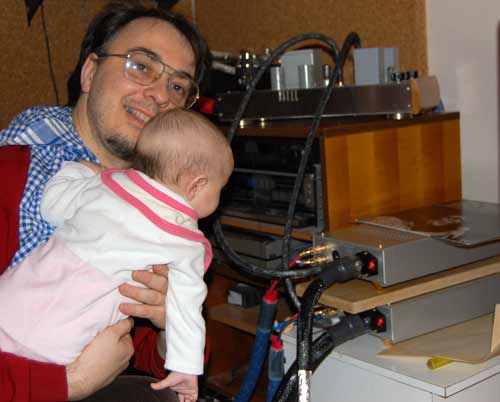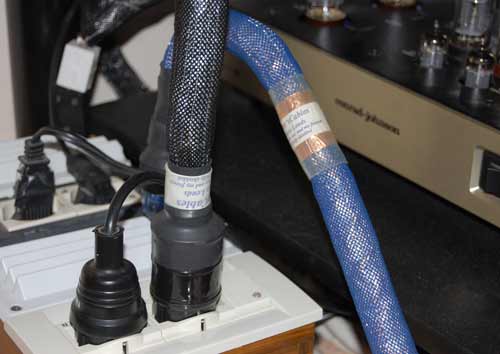

A Faber visit
Dear audio friends,
you have to know that I met Faber for the first time 5 years ago (25/01/2003),when a group of italian audiophiles asked me to organize a visit to the Kuzma atelier (near Kranj, Slovenia). Among them there was Aldo Zaninello, the man who builds the M Acoustic and the Sigma loudspeakers and who is behind the quite known White Gold cables. Because of the specific interest in the “cable world”, in the same group there was also Faber and, after that nice day (you can read a report of that session here), we became friends. I visited a few times his house near Padova and he came many times in my flat, just to listen my system and to try some of his new cables. It take really a short time before I become also a Faber Cables “user”, in particular for his signal cables, which I started to use as phono interconnection, but now have replaced almost all my Straight Wire Virtuoso Gold.
Every time that Faber has visited my flat he invited me to try his “power cords”, but I always answered that my Conrad-Johnson have their cables soldered internally and that I can't “try” another cable. He answered me simply to cut that “fabric” cable and try one of his, but I declined, because the cut was not a test but something “irreversible”. And so, for five long years we were good friends...
Two days ago Faber came to visit me. We played a little with a new “cheap” Faber cable to connect my MC step-up to the phono pre, but my usual Ag Faber cable was superior (even if more expensive). We also tried a new, not yet finished, Faber “Level-3 Soft” interconnection and it was clearly superior to mine. That was too easy and Faber decided to do a new game. Since I don't want to try his power cords with my CJ electronics, he have brought in my flat a “flying system” done with a chinese all-tube pre and two Murano digital power monoblocks.
|
|
|
The Chinese pre (from BEZ) was something very intriguing: it had 4 tubes in the power stage, including a 2A3! The output stage were NOS ECC83. But, more interestingly, there were also two output transformers and all the passive components were european NOS... uhmmm. Unfortunately, it seems that this pre is not easily available out of China. The Murano monoblocks are something more conventional, since they use the “classic” ICE power module (Bang and Olufsen) to obtain 200 W per channel. Made in Far East they are quite cheap.
|
|
|
Faber have sent me also a picture of the BEZ bottom and of its “brother” power amp, based on the 300B (which I have not yet auditioned). Look!
|
|
|
Using these components instead of my C-Js, Faber was finally able to add 3 new power cords (including a prototipe of his new Level-4 line) and a couple of loudspeakers 3-m long cables (which I didn't know that were quite expensive, since they are in the “Level-3 Soft” line). Of my system, there were playing only the analog front-end and the AZ Adagio loudspeakers. I was impressed by the sonic result. The soundstage was not much larger than mine, but there was more “air” between the instruments, which seemed more focused. Also, the sound was very rich and detailed, in a manner which remembered me the Cary 300B sound. Listening these system in my room was an interesting experience and I started to wonder how those “cheap” chinese electronics can surpass my C-J electronics in some parameters. May be that it was something due to the loudspeakers and power Faber cables?
The same evening we went to Trieste, were some Faber users were waiting his products. In their system (Teac mechanic, Stax DAC, Gryphon Diablo amp and B&W 802D loudspeakers) we also compared the prototype Level-4 and Level-3 Soft power cords against the owner's Level-3. Well, if I can't say that I was sure to hear a difference when the cable was changed on the Stax DAC, I'm sure that the Level-4 and Level-3 Soft produced a better image than the normal Level-3 when the cable was changed on the Teach mechanic. That was not the first time that I have listened improvements when playing with the Faber cables in other systems, but I always thought that it was not possible that could happen in my own system, since my C-J power cord were very good and done for those electronics, and so on... In any case, the chinese experience and this repeated experiment with Faber power cords were making me feeling more doubtful than ever.
Yesterday I have done it.
I have done what Faber was asking me for 5 years. I have cut the power cord coming out of my CJ DV-2b CD player and have finished the 5cm cord with a female IEC plug (costing 2 euro). See the right picture below.
|
|
|
I have just finished that work and connected the IEC plug to an old Faber Level-2 (or less?) cable that my wife had to go out and my “baby sitting turn” began. Then, I prepared a bottle and started my 5-months old daughter preferred music (“High Life”, from Jazz at the Pawnshop, FIM XRCD 012-013) on the “cold” CD player.
Jesus, what a bottle! Both of us were stacked, looking between the loudspeakers looking for Lars Erstrand!
Was that “High Life”? Was that my old CJ DV-2b CD player? Was that my system?
I know that it seems incredible (and I was the first who doubted for years!) but the result was unbelievable. There were much more things in that music than before! Since that moment to late night, one CD followed the other and here you can find some of the listened tracks, which I consider digital references.
“Canon in D”, Pachelbel, The All Star Percussion ensemble, FIM Audiophile Reference IV, FIM SACD 029.
“Dock of the Bay” and “In the Ghetto”, The Persuasions, A Cappella Dreams, Chesky JD251.
“Spanish Harlem”, Rebecca Pidgeon, The Raven, Chesky JD115.
“Fiume Sand Creek”, Fabrizio De Andrè, In direzione ostinata e contraria, Sony BMG 82876752322(3).
“Nastaran”, Savall family, Du temps & de l'instant, Alia Vox SACD AVSA9841.
“Di Perra Mora” and “Calata ala Spagnuola”, Camerata Iberia (Estevan, Mena), Songs and Dances from the Spanish renaissance, MA Recordings M035A.
Track 6 (including Dindirinin), Atrium Musicae Madrid (Paniagua family), Villancicos, Harmonia Mundi HMA 1901025.
“Homo fugit Velut umbra” and “Dirindin”, Stefano Landi, L'Arpeggiata (featuring Marco Beasley), Alpha 904.
What impressed more me were 2 parameters in particular: the first was the soundstage, which became larger, deeper and much higher (incredibly higher in Fiume Sand Creek!) and with a feeling of more space between every instrument. The feeling of “airy” was that which I have always associated to the analog sound! The second parameter which has substantially changed was the resolution. There are much more informations with the Faber power cord than before, with the factory internally soldered cord! These changes were dramatic! But why?
Why? WHY?!?
Many say that there is much “noise” in the main power network (in particular in the neutral wire) and that can saturate the main transformer or also cause problems to the diodes. If that is true, I can't believe that 1.5 m of power cord can filter out it, in particular after that the current has passed my 1:1 Audio Consulting transformer built for that purpose.
Others say that the power cord is an antenna which captures all radiofrequency and EMI signals in the air and bring them inside. If that is true, don't you think that a nice filter after the cable is a better solution? At least Mr Lew Johnson and Conrad think so, because they have implemented inside the DV-2b CD player a discrete component filter (using also an OMRON filter). The CJ DV-2b manual recites:
“Considerable care has been taken in the design of the DV-2b to minimize its susceptibility to radio frequency interference and other forms of electromagnetic interference (EMI). Choice of materials, physical layout, grounding practice, and power supply design have all been specified with a view to reducing the impact of electromagnetic fields on the performance of this unit and to assure that it does not radiate fields that may interfere with the operation of other units.”
Another, possibility is that the power cord is an antenna which radiates EMI, produced by the many power regulators and clock circuits, and reflected back in the main power supply. If that is the case, then a very well shielded cable (like the Faber Cables) could damp this radiation. On this point, the Conrad-Johnson manual recites:
“The installation should situate the DV-2b away from the preamplifier and other sources. Power (AC mains) cords should be dressed to remain at least 10cm away from audio signal cables, and from coaxial digital cables”.
I can't see other reasons to justify the change of cable effect and, even if this problematic is contemplated in the CJ manual, I would put Lew Johnson 1 month in prison because they sold the DV-2b (but also other components) with the power cord soldered inside. Of course, that is not the case of the actual products (including their very new CD player presented last week at CES).
You can think that I'm writing these stuff because I'm a friend of Faber and want him to sell more cables (prices in the 350-750 Euro range). Well, I think that as soon as he will become even more famous and internationally known (in all Italy he is already well known) he will see me more like a -poor- user than as a friend...
 Then,
I want to conclude this report with a simple suggestion: if you have
a power cord which come from inside your CD player (or mechanic unit
if you have an external DAC) don't wait 5 years before to cut that
cable and put a very well shielded (Faber or not!) power cord.
Then,
I want to conclude this report with a simple suggestion: if you have
a power cord which come from inside your CD player (or mechanic unit
if you have an external DAC) don't wait 5 years before to cut that
cable and put a very well shielded (Faber or not!) power cord.
For me, I'm just wondering if I can obtain similar effects from the Kuzma turntable cable (there is a radiating motor also there) or from the phono and preamplifier cables (in case of the receiving antenna effect). So, I think that other Faber Cables will join our system...
Tino © January 2008